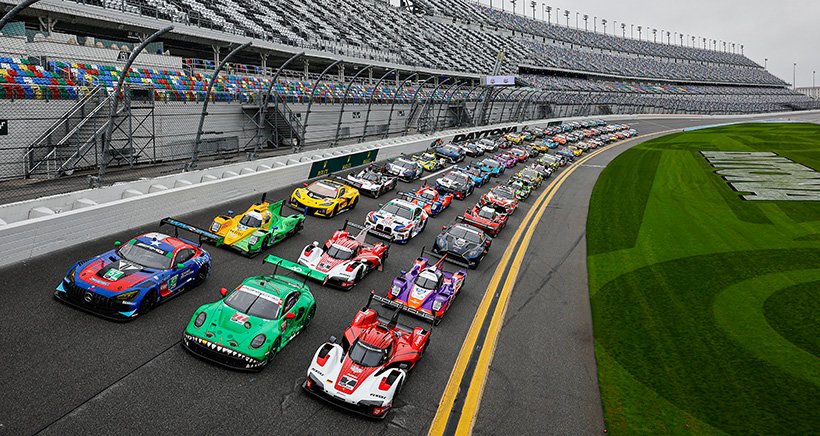Blog, Motorsports
The Thrilling 2025 Rolex Daytona 24 Hour Race: On Track Battles, Crashes, and Sim Racing Insights
Race Overview: A Glimpse of the 2025 Rolex Daytona 24 Hour Race
The Rolex Daytona 24 Hour Race, held annually at the iconic Daytona International Speedway, stands as a cornerstone of endurance racing within the motorsports calendar. The 2025 edition of this prestigious event is anticipated to be no exception, promising thrilling competition among an array of world-class teams and talented drivers. As a key highlight in the sports cars arena, the race is renowned for its grueling test of speed, strategy, and stamina, attracting top-tier participants from around the globe.
Set against the backdrop of the legendary speedway, the race is renowned not only for its challenging 3.56-mile course but also for its unique blend of day and night racing conditions that test the limits of both machines and their drivers. Competitors face significant hurdles, from the complexity of vehicle handling to the intricacies of race strategy, all while pushing their performance at high speeds in a bid for victory.
The 2025 iteration is expected to feature an exciting lineup of teams, each comprising skilled drivers well-versed in the art of endurance racing. Notable entries are predicted to come from manufacturers with rich legacies in the sport, adding further intrigue to the championship. Additionally, the rise of sim racing has brought forth a new wave of talent, with several drivers honing their skills in virtual environments before confronting the challenges posed by the real-world track.
This year’s event is not just about the competition; it encapsulates the spirit of camaraderie among participants and the fervent support from fans that fill the grandstands. With on-track battles intensifying and unexpected situations likely to arise, the 2025 Rolex Daytona 24 Hour Race is set to deliver breathtaking moments that will resonate through the history of motorsports. As the countdown to the race begins, excitement among enthusiasts grows, underscoring the event’s place as a must-see spectacle in the realm of sports cars and endurance racing.
On Track Battles and Dramatic Crashes
The 2025 Rolex Daytona 24 Hour race proved to be an exhilarating showcase of endurance racing, where sports cars dueled fiercely on the legendary track. This year’s competition saw teams and drivers engage in strategic overtakes, utilizing both skill and teamwork to edge past their rivals. The intensity of the on-track battles characterized the essence of IMSA racing, as participants displayed remarkable resilience and tactical prowess throughout each lap.
Notable rivalries emerged during the 24-hour marathon, with drivers pushing the limits of their performance. Key moments included an aggressive maneuvering between two leading teams, which formed the highlight of the event. One team’s ability to execute precise pit stops while maintaining speed on the course ultimately tipped the scales in their favor. The fans witnessed heart-stopping overtakes, where split-second decisions made all the difference, showcasing the dynamic nature of motorsports at its finest.
As the event unfolded, the interplay between fierce competition and dramatic incidents created a captivating narrative that resonated with fans. Highlights of the race illustrated the thrilling dimensions of sim racing, as drivers contended not only with each other but also with the unpredictable nature of endurance racing. This blend of intensity and unpredictability is what makes the Rolex Daytona 24 Hour race a standout event in the motorsports calendar.
Fun Facts About Popular Teams: The Titans Behind the Cars
The Rolex Daytona 24 Hour race is a hallmark of endurance racing, showcasing not only exceptional sports cars but also the teams and drivers who push their limits. Teams like Team Penske, Action Express Racing, and Chip Ganassi Racing have carved their names into the annals of motorsports history. Team Penske, for instance, has a storied legacy that includes numerous victories across various categories, including IMSA competitions. This team’s commitment to excellence is exemplified by their remarkable performance at the Daytona 24, where they have consistently challenged their rivals and secured multiple podium finishes.
Meanwhile, Action Express Racing is known for its collaborative spirit and strategic prowess. They have earned a reputation for executing flawless pit stops and race strategies, making them a formidable force in endurance racing. Since their first race in the early 2000s, they have captured a number of prestigious titles, which has cemented their status as a top competitor in IMSA. Interestingly, they have a unique tradition of involving their enthusiastic fan base through engaging social media campaigns and events, making spectators feel a part of the team’s journey.
Chip Ganassi Racing is another iconic name synonymous with victory. Their approach to sim racing allows them to scout and develop new talent, which has propelled drivers such as Scott Dixon and Marcus Ericsson into the limelight. In fact, they have a fierce rivalry with Team Penske that adds a layer of excitement to the Daytona 24; their battles on the track are nothing short of thrilling. The dynamic between these teams, complete with historical anecdotes and passionate fan interaction, exemplifies the camaraderie and competition that define not just the race, but the spirit of motorsports.
Sim Racing: Bridging Virtual and Real-Life Competition for Drivers
In recent years, sim racing has emerged as a pivotal tool for aspiring and professional drivers, particularly in the realm of endurance racing, such as the prestigious Rolex Daytona 24 Hour Race. This virtual motorsports environment offers a myriad of benefits, simulating the complexities of racing sports cars while allowing drivers to hone their skills in a controlled setting. With advancements in technology, the experience has become more immersive, transforming how athletes prepare for real-world challenges.
The equipment used in sim racing plays a significant role in replicating the feel of actual racing. Drivers often utilize high-quality wheels and pedals, which provide realistic feedback, mimicking the conditions encountered during an actual race. Moreover, the integration of virtual reality (VR) setups further enhances the immersive experience, making virtual tracks feel strikingly similar to their real-life counterparts. By practicing in these environments, drivers can familiarize themselves with track layouts and optimize their performance strategies, critical for succeeding in the demanding Daytona 24.
Training programs specifically designed for sim racing have become increasingly popular. These programs often include meticulously crafted camber setups that adjust to various racing conditions, enabling drivers to experience the nuances of vehicle handling. Testimonials from seasoned racers reveal that sim racing significantly enhances their ability to navigate complex race scenarios. High-profile racers have credited their virtual racing experience for improving their reaction times and decision-making skills on the track.
As the line between virtual and real-life competition continues to blur, sim racing is establishing itself as a vital component in the preparation of drivers for elite events like the Rolex Daytona 24. By embracing this innovative training method, drivers can ensure they are fully equipped to tackle the challenges of endurance racing, making sim racing an indispensable aspect of modern motorsports training. In conclusion, the seamless integration of this virtual platform with real-world racing is transforming how individuals approach their careers in motorsports.



